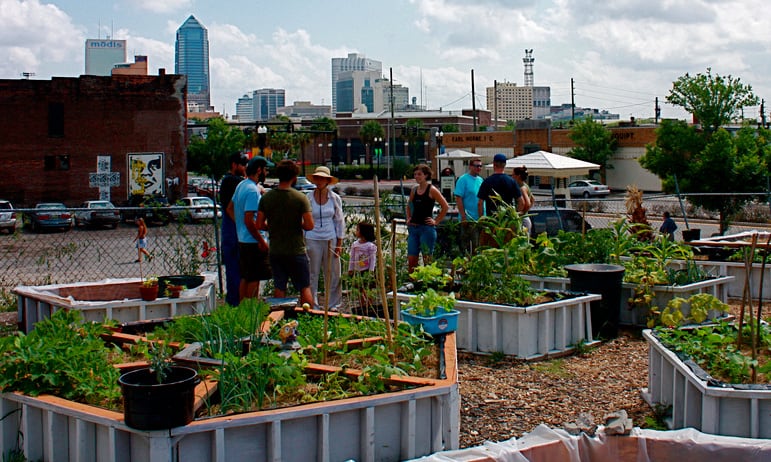The Of City Blooming
The Of City Blooming
Blog Article
The Definitive Guide to City Blooming
Table of ContentsAn Unbiased View of City BloomingCity Blooming Fundamentals ExplainedTop Guidelines Of City BloomingThe Greatest Guide To City BloomingCity Blooming Fundamentals Explained
Interested in growing food for sale in the City of Chicago? Below is a checklist of often asked inquiries pertaining to the guidelines and guidelines that cultivators should consider when preparing an urban farming task.
The zoning amendment does not customize any other codes managing composting, building authorizations, buying or renting City owned property, service licenses or environmental contamination. There are existing codes that control these concerns and they stay in full impact and might apply to your project. Neighborhood yards are typically had or taken care of by public entities, civic companies or community-based organizations and preserved by volunteers.
Urban farms grow food that is meant to be sold, either on a nonprofit or for-profit basis. As a result of their business objective, urban farms need a business license. Yes. A neighborhood yard is permitted to market excess create that was expanded on website if the sales are accessory or subordinate to the yard's key purpose explained over.
City Blooming Fundamentals Explained
The amount of garden compost material can not surpass 25 cubic yards at any kind of given time according to the standards in 7-28-715 of the City's Municipal Code. Due to the fact that the soil at the majority of new garden websites needs changing, compost, soil, timber chips, or other materials can be gotten to construct or boost the growing room.

If a building license is required after that the hoophouse will be taken into consideration an accessory structure. You can discover more about the structure permit needs by speaking to the Department of Structures. The 25,000-square-foot size limitation is intended to avoid a solitary community yard from dominating an offered block or diminishing the block's existing household or industrial personality.
The limitation does not use to gardens located in Public Open Room (POS) areas. Can there be more than one area garden that is 25,000 square feet on a solitary block? Fence is not needed, however, gardens that have big auto parking locations may be required to set up secure fencing or other landscaping attributes.
The 7-Second Trick For City Blooming
B1 & B2 districts call for that all business use activities be conducted inside. Is secure fencing required for metropolitan farms? Fencings might be needed, along with landscape design and testing, for specific car parking locations and outside Check This Out work or storage space locations depending on area and the particular activity taking place.
Yes. Urban farms need building permits and zoning authorizations prior to construction. Various other types of city review may be required relying on details structures, activities, size, landscaping, licensing, public health and stormwater management concerns. A number of these demands are recognized in the job layout or permitting procedure, nonetheless, the applicant might be responsible to separately determine certain licenses or allows that might be called for.
The Department of Service Affairs and Consumer Protection can aid identify the particular kind of service certificate that's needed. Off road parking is needed for most commercial projects in Chicago. The needed number of car parking rooms is based on the number of workers working on website and not the square footage of the expanding area.
The 20-Second Trick For City Blooming

A city ranch can offer garden compost material created on site, however, the operation must conform with the guidelines in 7-28-715 of the Chicago Municipal Code. Aquaponic systems are enabled indoors on metropolitan farms in lots of zoning districts.
As much as five hives or colonies of honey might be kept as an accessory usage. Nonetheless, beekeepers must sign up with the Illinois Division of Agriculture. For more details about the proposed zoning modification you might speak to the Division of Housing and Economic Development, Bureau of Planning and Zoning at 312.744.8563.
Farming in cities and urban areas An urban farm in Chicago. Urban farming describes various practices of cultivating. https://www.goodreads.com/user/show/179466644-daniel-nold, processing, and distributing food in urban areas. The term additionally applies to the area activities of animal husbandry, aquaculture, beekeeping, and gardening in an urban context. Urban farming is distinguished from peri-urban agriculture, which takes place in backwoods beside suburbs.
The Definitive Guide for City Blooming
, who look for to develop social networks founded on a shared values of nature and area holism. These networks can create by way of official institutional support, becoming incorporated right into neighborhood community planning as a "shift town" motion for sustainable metropolitan growth.
Some of the very first evidence of urban farming comes from Mesopotamia.
Report this page